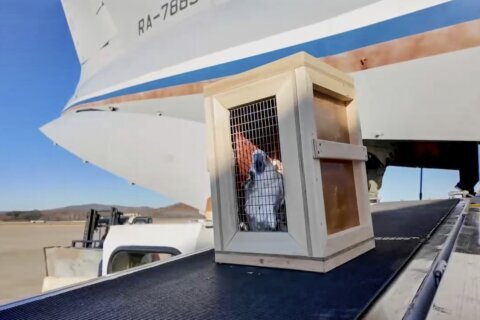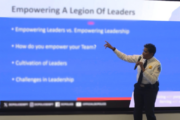ROSSTON, Texas (AP) — The cattle part as Meredith Ellis edges her small four-wheeler through the herd, silently counting the cows and their calves. It’s the way she starts most days on her 3,000-acre Texas ranch: ensuring all the cattle are safe, deciding when they should move to another pasture, and checking that the grass is as healthy as her animals.
“We’re looking for the sweet spot where the land and cattle help each other,” Ellis says as she rumbles down a narrow dirt road to check on another herd. “You want to find that balance.”
Much of Ellis’ work evolved from the ranching her father practiced for decades. Her parents built this ranch, and it’s where Ellis was raised, roaming with her brother through pastures, creeks and hardwood forests as the family added land and cattle over the years.
Now it’s Ellis’ turn to make the decisions. She’s implemented changes her father couldn’t dream of — because for her and other ranchers, their livelihoods and the future of the planet are on the line.
For generations, beef has been a way of life in Texas, the most quintessential of American main courses, and a premium protein around the world. It’s also the single most damaging food for the planet. Beef is the largest agricultural source of greenhouse gasses worldwide, and it has a bigger carbon footprint than any other type of protein.
Climate scientists say the answer is simple: Eat less beef and raise fewer cattle. But even with the wide availability of plant protein and the popularity of initiatives like Meatless Monday, most people around the world are consuming more beef, not less. And as the population grows and more people move into the middle class, demand is only expected to grow.
___
EDITORS’ NOTE — This story is part of The Protein Problem, an AP series that examines the question: Can we feed this growing world without starving the planet? To see the full project, visit https://projects.apnews.com/features/2023/the-protein-problem/index.html
___
Ellis finds herself at ground zero. Texas has by far the most cattle in the U.S., which is the biggest producer of beef in the world. Here, beef has long been a staple of Americana, from cowboy Westerns and cattle drives to barbecue joints and meat judging contests. And it’s here that Ellis believes she can make a difference.
“I don’t want to do this if it isn’t good for the environment,” Ellis said. “I want ranching to be part of the climate solution.”
Researchers and a growing number of ranchers agree — they believe there are solutions that address climate change and fill demand, for a world in which people can buy, cook and eat beef with a clear conscience. They point to efforts to change how cattle are raised to retain more carbon in the ground, to develop feed supplements that reduce gas releases, and to make genetic breakthroughs so animals digest their food without brewing up harmful gases.
For Ellis, the solution lies in the practice of regenerative ranching. In theory, it’s a holistic way to look at the earth, animals, and water — and how they all interact. In practice, it’s an exhausting, never-ending process of moving her cattle to different pastures in an effort to restore the soil.
“What I’m looking to do is make a major impact and completely redefine the beef industry,” Ellis, 41, said. “I want to take everyone with me.”
THE BASICS OF BEEF
Ellis took over the family ranch, north of Dallas, in 2013. She’s faced all the critical questions surrounding the beef industry: How can ranchers keep up with inflation? How can producers wrestle back some control in an industry dominated by multinational slaughterhouse companies? Should herd numbers be reduced amid long-term drought?
But no issue has been more important than beef’s contribution to climate change. Cattle belch out serious amounts of greenhouse gases, especially methane — about 220 pounds a year of methane, which is 80 times more harmful than carbon dioxide, the main greenhouse gas spewed out by cars.
Cattle do it by bathing their swallowed food in about 40 gallons of liquid teeming with microbes. Those little bugs create the energy that feed cattle, but they also ferment the food, brewing up lots of methane, carbon dioxide and nitrous oxide that cows release.
Cows are classified as ruminant mammals, which means they regurgitate, chew and rechew the cud until it can be properly digested. Once broken down, another chamber of the stomach, the omasum, filters out everything but water and the finest food particles. When food reaches the final stomach of the cow, the abomasum, the digestion system starts to look very similar to that of other animals, where acids further break down food and allow for the absorption of nutrients.
It’s the same with all ruminant animals, from wild deer to domesticated goats and sheep. Cattle get more attention because there are so many of them — 90 million in the U.S. — and because their size means a lot of gas.
Most cattle are fed grain — largely corn — in their final months of life, in feedlots. Growing that grain also produces greenhouse gases, from diesel burned in farm equipment and fertilizer sprayed on fields.
Overall, beef production creates enough carbon that cutting herd sizes by even 10% to 20% could make a difference, experts agree.
They also agree that reducing consumption, particularly in America, is a clear place to start. Americans eat the equivalent of about three hamburgers a week, research shows, and if they cut that in half and instead export U.S. beef to other countries, the world would have a greater chance of meeting demand without cutting forests and expanding cattle grazing lands.
That’s because the U.S. beef industry is much more efficient than that of most other countries, thanks to higher-quality feed, better animal genetics and use of feedlots. The U.S. produces 18% of the world’s beef with about 6% of its cattle.
SEARCHING FOR SOLUTIONS
For Ellis, regenerative ranching is not only the most efficient but the most environmentally responsible route. Growing up in the tiny community of Rosston, Ellis dreamed of moving to a big city, far from Texas.
After high school, she studied landscape architecture at the University of New Mexico, but little by little, her dreams changed. The more she learned about land use and design, the more she wanted to preserve and improve her family’s land.
“It dawned on me just how very special this land was,” she said, “and I realized the importance of coming home and continuing for all of us.”
That thinking eventually led her to the theories of regenerative ranching, which harken back to the 30 million bison that once thundered through the Plains states. Herds would seemingly annihilate grasslands by eating all the vegetation and pummeling the ground with their hoofs. The ground looked trashed, but those hoofs stimulated the soil, and the animals coated the ground with nitrogen-rich waste. Then, the animals left for months or even years, allowing grasses to grow and establish deep, sturdy roots.
Regenerative ranchers try to do roughly the same by moving cattle frequently. They’re kept in spaces where they can trample the grass and soil and then move on, allowing the land to recover for weeks or months. The goal is to produce more grass that will generate deep roots to take carbon from the air and permanently store it underground.
For Ellis, regenerative ranching means moving her family’s herd of 320 cows, calves and heifers plus several bulls through 58 fenced pastures. Ellis and her ranch manager further subdivide those pastures using temporary, electrified line they can quickly string to confine cattle in even smaller areas.
In daily checks, they examine not only the animals but the grass. By building it to be resilient and hardy, Ellis wants not only to store more carbon but to reduce the need for hay or other feed that use up more land.
“It’s a state of symbiosis to where the cattle benefit from the land and the land benefit from the cattle,” said Ellis, whose family in years past left cattle for much longer periods on far larger pastures.
In most ranches, that’s still how it’s done. Thousands of ranchers are incorporating regenerative practices but only a small percentage have completely transformed their operations because they don’t think it’s necessary or aren’t able to devote the time, labor and land to such an effort.
Ellis has opened her ranch to researchers from the nonprofit Ecosystem Services Market Consortium for readings from hundreds of sites. So far, their study shows Ellis’ work is making a difference: Each year the ranch is sequestering about 2,500 tons of atmospheric carbon dioxide — equivalent to the annual emissions from about 500 cars. And that number has inched up as Ellis makes more changes at the ranch.
Randy Jackson, an agronomy professor at the University of Wisconsin, Madison, cites efforts like Ellis’ and argues the U.S. needs more cattle grazing, not less: “Well-managed grazing on perennial grasslands is our best and maybe our only hope of helping to mitigate climate change.”
INDUSTRYWIDE, CHANGE IS UNDERWAY
Even as ranchers like Ellis push ahead with their practices, other efforts are gaining traction to mitigate ranching’s effect on climate, with some of the most promising work revolving around genetics.
At Scotland’s Rural College, animal genetics professor Rainer Roehe has used breeding based on genetic traits to reduce methane emissions in cattle by 17% for each generation, with those traits passing on to future offspring and cutting methane emissions by 50% over 10 years.
Genetics professor Ann Staiger at Texas A&M University, Kingsville, also is exploring cattle genetics with help from a $4.7 million federal grant in hopes of determining which breeds produce less greenhouse gases.
“Greenhouse gas emissions are highly correlated with feed intake, so if we can find the cattle that have lower feed intake, we’ll also measure their greenhouse gas emissions and hopefully see that tie,” Staiger said.
New Zealand has been especially aggressive in seeking ways to reduce greenhouse gas emissions. As the government pursues plans to tax farmers for their animals’ methane emissions, researchers are studying everything from genetics to vaccines and supplements.
And at the University of California-Davis and Colorado State University, research centers on supplements that can be fed to dairy cows and beef cattle on feedlots, where most U.S. cattle spend their final four to six months before slaughter.
Feedlots can be ugly, with manure runoff and animals standing on packed dirt with little shade. But they have advantages: Steady feed enables cattle to put on weight more quickly, and the less time a cow lives, the less greenhouse gases produced.
The Colorado State effort, led by a new group called AgNext, hopes to reduce those gases further and delve into other sustainability issues with its testing of cattle supplements at a small feedlot built near its main Fort Collins campus. AgNext is partially funded with money from the beef industry; researchers say they have limited federal funds and want to work closely with producers to implement findings.
At AgNext, the methane, carbon and other gases that cattle breathe out are measured in feeders called green bins, and other equipment keeps track of how much they eat and weigh. It’s all an effort to take out the guesswork and analyze how cattle respond to the experimental feeds, or supplements.
AgNext is headed by Kim Stackhouse-Lawson, a professor of animal science whose livestock fascination dates to age 6, when she met her first sheep at a Northern California fair. By high school, she was raising a flock of 400. Now, she wants to lead AgNext and the industry to quick, dramatic improvements.
“It was what was needed,” she said of AgNext. “A new way to think about partnering a university with a supply chain, and a new group of people to focus just on innovation, to really transform the way we raise animals.”
On an icy March morning, that innovation starts just after dawn with 21-year-old graduate student Maya Swenson.
She oversees one of the first projects at AgNext, and she’ll get plenty warm tearing open and lifting 50-pound bags of minerals and supplements, then blending a “cattle casserole” to be mixed in a truck with tons of grass feed.
Alfalfa pellets act as a treat to attract cattle to the green bins and then keep them eating while gas emissions are measured.
The cows — backs covered in snow, breath creating white clouds in the cold air — are important to Swenson, who hopes to bring more sustainable practices to the industry.
“I want to be on that side of: How we are taking what we’ve learned and giving it to producers so they can improve their operations?” she said.
“THE MOST IMPORTANT THING”
Ellis has seen how global warming is altering her land. She calls it an “existential crisis,” the backdrop to the endless to-do list that comes with regenerative ranching.
After a long day, she likes to take a moment to remember why she does it. Standing with her 6-year-old son on a cool evening, they watch over a gate as dozens of cows graze amid the lush grass and a setting sun.
“I could stand here all evening,” she says.
Ellis knows she could make more money selling in a niche market. Others in Texas’ regenerative ranching circles have taken to social media to promote their cattle to people who don’t know the difference between a heifer and a Holstein. It can be lucrative, leading to consulting deals and top-tier prices for cows sold directly to consumers.
Ellis could find customers, with one of the nation’s largest metro areas only an hour’s drive away. Plenty of people would pay for beef raised on a ranch like hers — with more than 500 species of plants and animals, and clear streams and shady groves that shelter her cattle from the Texas heat.
But Ellis has other plans.
She’s taken a leadership role in a group that wants to see industry-wide change, with animal welfare and land sustainability practices eventually leading to higher prices for ranchers who adapt.
She also knows she could make millions selling her land for development into a subdivision of tidy suburban homes — it’s already happening a few miles down the road. But she can’t bring herself to do it.
She figures that keeping the land as a ranch and doubling down on her efforts represent a multimillion-dollar investment in the future of the planet.
“That is the most important thing I could possibly do with my life,” Ellis said. “At the end of the day, no amount of money or anything could persuade me to do otherwise.”
___
The Associated Press Health and Science Department receives support from the Howard Hughes Medical Institute’s Science and Educational Media Group. The AP is solely responsible for all content.
Copyright © 2024 The Associated Press. All rights reserved. This material may not be published, broadcast, written or redistributed.







